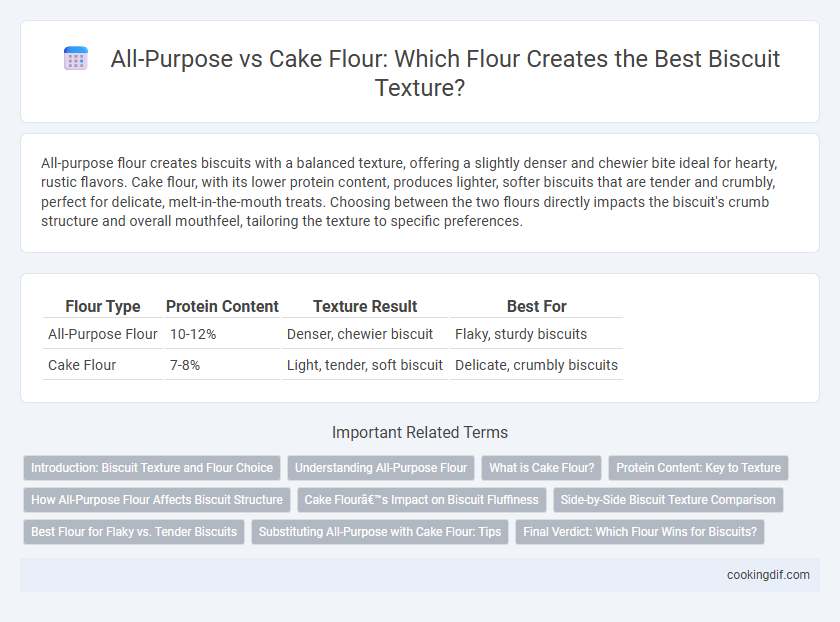All-purpose flour creates biscuits with a balanced texture, offering a slightly denser and chewier bite ideal for hearty, rustic flavors. Cake flour, with its lower protein content, produces lighter, softer biscuits that are tender and crumbly, perfect for delicate, melt-in-the-mouth treats. Choosing between the two flours directly impacts the biscuit's crumb structure and overall mouthfeel, tailoring the texture to specific preferences.
Table of Comparison
| Flour Type | Protein Content | Texture Result | Best For |
|---|---|---|---|
| All-Purpose Flour | 10-12% | Denser, chewier biscuit | Flaky, sturdy biscuits |
| Cake Flour | 7-8% | Light, tender, soft biscuit | Delicate, crumbly biscuits |
Introduction: Biscuit Texture and Flour Choice
Biscuit texture heavily depends on flour type, with all-purpose flour providing a balanced protein content that results in a tender yet sturdy crumb. Cake flour, with its lower protein percentage, yields lighter, softer biscuits that may lack the desirable flakiness. Choosing between all-purpose and cake flour directly influences biscuit rise, crumb structure, and overall mouthfeel.
Understanding All-Purpose Flour
All-purpose flour contains a moderate protein content, typically around 10-12%, which provides a balanced gluten structure ideal for tender yet slightly chewy biscuits. Unlike cake flour, which has lower protein and produces a softer crumb, all-purpose flour yields a texture with enough strength to hold shape while remaining flaky. Choosing all-purpose flour helps achieve biscuits that are versatile in texture, suitable for both soft and crisp finishes depending on the baking method.
What is Cake Flour?
Cake flour is a finely milled, low-protein flour typically containing 7-8% protein, which results in a softer, more tender crumb ideal for delicate baked goods like biscuits. Its lower gluten content compared to all-purpose flour, which has about 10-12% protein, reduces chewiness and creates a lighter, fluffier texture in biscuits. Using cake flour can enhance biscuit tenderness but may require adjustments in liquid ratios due to its higher starch content.
Protein Content: Key to Texture
Protein content plays a crucial role in determining biscuit texture, with all-purpose flour typically containing 10-12% protein and cake flour around 7-9%. Higher protein levels in all-purpose flour develop more gluten, resulting in denser, chewier biscuits, while the lower protein in cake flour yields lighter, tender crumb structures. Choosing the appropriate flour type allows bakers to control biscuit texture from flaky and tender to firm and soft.
How All-Purpose Flour Affects Biscuit Structure
All-purpose flour contains a moderate protein content, typically around 10-12%, which promotes a balanced gluten development essential for biscuit structure. This gluten network provides biscuits with a slightly denser and chewier texture compared to cake flour, which has lower protein levels. Using all-purpose flour results in biscuits with a tender crumb and enough strength to hold fillings or toppings without crumbling easily.
Cake Flour’s Impact on Biscuit Fluffiness
Cake flour contains less protein than all-purpose flour, resulting in lower gluten formation and a softer, more tender biscuit crumb. This reduced gluten network allows biscuits to rise higher and achieve a noticeably fluffier texture. Using cake flour enhances moisture retention, contributing to the delicate, melt-in-your-mouth quality preferred in flaky biscuit recipes.
Side-by-Side Biscuit Texture Comparison
All-purpose flour provides a denser, chewier biscuit texture due to its higher protein content, resulting in a sturdier crumb ideal for savory biscuits and hearty sandwiches. Cake flour yields a softer, lighter biscuit with a tender crumb, attributed to its lower protein content and finer grind, making it perfect for delicate, melt-in-your-mouth biscuits. Side-by-side biscuit texture comparison highlights that all-purpose flour biscuits hold shape better while cake flour biscuits excel in fluffiness and crumb tenderness.
Best Flour for Flaky vs. Tender Biscuits
All-purpose flour provides a balanced protein content of around 10-12%, making it ideal for flaky biscuits with a slightly chewy texture. Cake flour, with its lower protein content of about 7-9%, produces tender, soft biscuits due to less gluten development. Choosing all-purpose flour yields biscuits with a delicate crispness and layered flakiness, while cake flour ensures a melt-in-the-mouth tenderness perfect for softer biscuit varieties.
Substituting All-Purpose with Cake Flour: Tips
Substituting all-purpose flour with cake flour in biscuit recipes enhances tenderness due to cake flour's lower protein content, resulting in a softer, more delicate texture. To maintain structure, incorporate a slight increase in flour quantity or reduce liquid slightly, as cake flour absorbs less moisture. Sifting cake flour before mixing and avoiding overworking the dough prevents toughness and promotes flaky biscuits.
Final Verdict: Which Flour Wins for Biscuits?
All-purpose flour provides a balanced protein content around 10-12%, resulting in biscuits with a sturdy yet tender crumb, ideal for versatile baking needs. Cake flour, with its lower protein content of about 7-8%, produces lighter, more delicate biscuits with a soft texture but less structural integrity. For biscuit bakers prioritizing fluffy texture without sacrificing strength, all-purpose flour is the recommended choice, delivering optimal rise and crumb.
All-purpose vs cake flour for biscuit texture Infographic

 cookingdif.com
cookingdif.com